Here’s a trick question: What does it take for 5 villages to sustainably coexist with an island’s ecosystem? Answer: the mindset that they are an intrinsic part of the ecosystem.
that they are an intrinsic part of the ecosystem.
Human activity inside a complex and diverse island environment is often difficult to balance against what the rest of the organisms within require to thrive. According to the United Nations ![clip_image002[5] clip_image002[5]](http://lh6.ggpht.com/_ibCqaP4tBDM/S69mfxeDk-I/AAAAAAAAAOw/-RbsOUVItv8/clip_image002%5B5%5D_thumb%5B1%5D.jpg?imgmax=800) Environment Program (UNEP), the most diverse region of the world for coral reefs is centered on the Philippines, Indonesia, Malaysia and Papua New Guinea, with between 500 and 600 species of coral in each of these countries. Unfortunately these are also some of the most threatened coral reefs in the world. The UNEP publication World Atlas of Coral Reefs (2001), rang the alarm bells when it
Environment Program (UNEP), the most diverse region of the world for coral reefs is centered on the Philippines, Indonesia, Malaysia and Papua New Guinea, with between 500 and 600 species of coral in each of these countries. Unfortunately these are also some of the most threatened coral reefs in the world. The UNEP publication World Atlas of Coral Reefs (2001), rang the alarm bells when it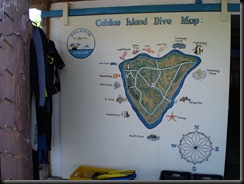 reported that 97 percent of reefs in the Philippines are under threat from destructive fishing techniques, including blast fishing, cyanide poisoning, overfishing, or from deforestation and urbanization that result in harmful sediment spilling into the sea. Of the estimated 27,000 square kilometers of coral
reported that 97 percent of reefs in the Philippines are under threat from destructive fishing techniques, including blast fishing, cyanide poisoning, overfishing, or from deforestation and urbanization that result in harmful sediment spilling into the sea. Of the estimated 27,000 square kilometers of coral 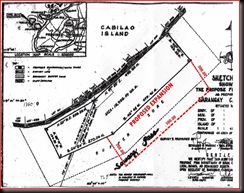 reef, only 5% remain in “excellent condition” (Reef Check, as quoted in previous link). Cabilao Island’s reefs seem to belong to the 5%.
reef, only 5% remain in “excellent condition” (Reef Check, as quoted in previous link). Cabilao Island’s reefs seem to belong to the 5%.
Cabilao Island in Bohol Province is a prime scuba diving destination, boasting of giant fan and table corals, wall dives pockmarked with 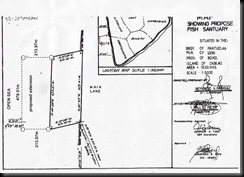 dark and foreboding crevices, schools and schools of reef fishes, and occasional sightings of thresher sharks and hammerheads. Even the resort operators in nearby Cebu Island bring their diver-guests here, despite the 2-hour travel time by boat.
dark and foreboding crevices, schools and schools of reef fishes, and occasional sightings of thresher sharks and hammerheads. Even the resort operators in nearby Cebu Island bring their diver-guests here, despite the 2-hour travel time by boat.
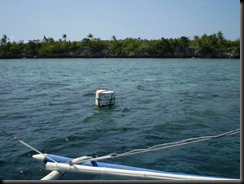 Sport scuba diving and the tourists the industry brings is a major source of income for the communities. Three resorts in the island cater to the tourists, and the communities support the resorts with manpower, as well as excess fish and vegetables they manage to catch or harvest.
Sport scuba diving and the tourists the industry brings is a major source of income for the communities. Three resorts in the island cater to the tourists, and the communities support the resorts with manpower, as well as excess fish and vegetables they manage to catch or harvest.
In 2001, Cabilao’s villages (Talisay, Cambaquiz, Cabacungan, Looc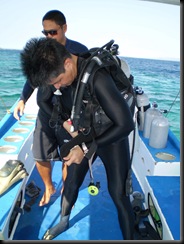 and Pantudlan) established two Marine Protected Areas (MPAs), one in Barangay Pantudlan (10 hectares) and another in Barangay Cabacungan (11.8 hectares) to address the growing need to ensure the protection of their reefs. At about this time, many dive destinations in other areas, notably the Jessie Beazley and Bastera Reefs in the Sulu Sea, have become so damaged by destructive fishing methods that many dive tour operators stopped offering them as
and Pantudlan) established two Marine Protected Areas (MPAs), one in Barangay Pantudlan (10 hectares) and another in Barangay Cabacungan (11.8 hectares) to address the growing need to ensure the protection of their reefs. At about this time, many dive destinations in other areas, notably the Jessie Beazley and Bastera Reefs in the Sulu Sea, have become so damaged by destructive fishing methods that many dive tour operators stopped offering them as 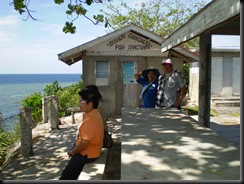 destinations. Having one of the most intact reefs in the country firmly positioned Cabilao as a must-see diving destination.
destinations. Having one of the most intact reefs in the country firmly positioned Cabilao as a must-see diving destination.
Early this year, the island’s villagers, through PROCESS Bohol (our NGO partner), asked Seacology for assistance in refurbishing a long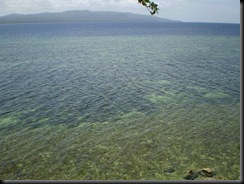 abandoned Spanish-era lighthouse on the northwestern tip of the island. The intention is to convert it into a Tourist Information Center that will promote inland tourism and showcase their handcrafted mats and bags. In exchange, they agreed to extend the existing MPAs by 10 hectares more each,
abandoned Spanish-era lighthouse on the northwestern tip of the island. The intention is to convert it into a Tourist Information Center that will promote inland tourism and showcase their handcrafted mats and bags. In exchange, they agreed to extend the existing MPAs by 10 hectares more each, 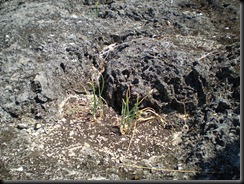 and to actively protect these for at least 20 years.
and to actively protect these for at least 20 years.
I visited the project site last March 26 and 27, 2010. Emmie Roslinda, PROCESS Bohol’s Executive Director, and Rey Monreal of the Municipal Government, were my patient and solicitous companions and guides.
Scuba diving on the MPAs was first on the agenda. No mean feat, considering strictly no activity whatsoever is allowed within. I am told that in the early years of the MPAs, a reef guard himself was found fishing 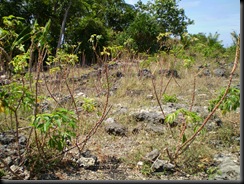 in the Cabacungan MPA. He was severely reprimanded and penalized with such a hefty fine that no one else gave a thought to violating the MPAs since. My dive buddy was Alain, a divemaster and instructor of the Polaris Beach and Dive Resort.
in the Cabacungan MPA. He was severely reprimanded and penalized with such a hefty fine that no one else gave a thought to violating the MPAs since. My dive buddy was Alain, a divemaster and instructor of the Polaris Beach and Dive Resort.
If you will imagine two doors of average dimension side by side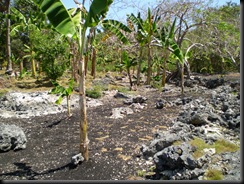 underwater, that would be the approximate size of the biggest fan coral that greeted us at the Cabacungan MPA. Schools of batfish, surgeonfish, rabbitfish, purple antheas, and other reef fishes abound. Over at the Pantudlan MPA, huge
underwater, that would be the approximate size of the biggest fan coral that greeted us at the Cabacungan MPA. Schools of batfish, surgeonfish, rabbitfish, purple antheas, and other reef fishes abound. Over at the Pantudlan MPA, huge 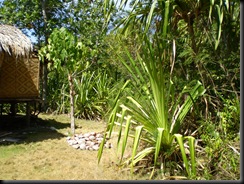 table corals, some about 3 meters across, cover the edges just before the drop-off. We saw reef fishes similar to those of Cabacungan, as well as a few barracudas. A testament to the integrity of the MPAs, it was Alain’s first time to dive the MPAs too, and he was very grateful for the opportunity.
table corals, some about 3 meters across, cover the edges just before the drop-off. We saw reef fishes similar to those of Cabacungan, as well as a few barracudas. A testament to the integrity of the MPAs, it was Alain’s first time to dive the MPAs too, and he was very grateful for the opportunity.
Diving and traditional fishing are restricted to areas outside the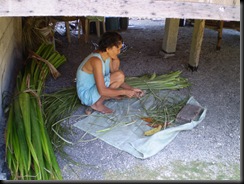 MPAs, and the spillover marine life seems sufficient for the needs of the dive industry and fisherfolk. But the villagers do not rely solely on what the ocean provides. An imaginative, environment-friendly farming method they fondly call “rock farming” has, well, gained ground in the island.
MPAs, and the spillover marine life seems sufficient for the needs of the dive industry and fisherfolk. But the villagers do not rely solely on what the ocean provides. An imaginative, environment-friendly farming method they fondly call “rock farming” has, well, gained ground in the island. 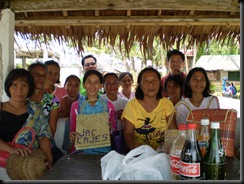 Onions, casava, rice and corn are grown from small pockets of fertile soil that have accumulated on rocky surfaces. Their onions, the farmers swear, are the biggest and sweetest anywhere. In fact, merchants from mainland Bohol would travel to Cabilao to snap up the onions as soon as these are
Onions, casava, rice and corn are grown from small pockets of fertile soil that have accumulated on rocky surfaces. Their onions, the farmers swear, are the biggest and sweetest anywhere. In fact, merchants from mainland Bohol would travel to Cabilao to snap up the onions as soon as these are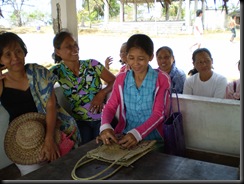 harvested, and very few, if any, remain for export outside of the province.
harvested, and very few, if any, remain for export outside of the province.
Also, Cabilao is known for the beautiful mats and bags that its residents, mostly women, weave from the ubiquitous romblon plant (Pandanus sp.) of the island. The Cabilao Romblon Weavers 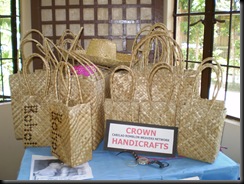 Network (CROWN) is the island’s association of weavers, with its own president, board of directors, and quality control group. Meeting them on Day 2 is one of the highlights of the trip, as I came to observe firsthand how the womenfolk discuss the orders in the pipeline (500 just met, 100 just
Network (CROWN) is the island’s association of weavers, with its own president, board of directors, and quality control group. Meeting them on Day 2 is one of the highlights of the trip, as I came to observe firsthand how the womenfolk discuss the orders in the pipeline (500 just met, 100 just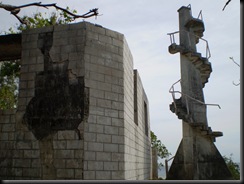 placed), their plans to procure a high-speed sewing machine (for the bag zippers) from their earnings, and their ideas for the interior layout of the soon to be converted lighthouse. Their optimism, resourcefulness and industry, I think, is worth
placed), their plans to procure a high-speed sewing machine (for the bag zippers) from their earnings, and their ideas for the interior layout of the soon to be converted lighthouse. Their optimism, resourcefulness and industry, I think, is worth 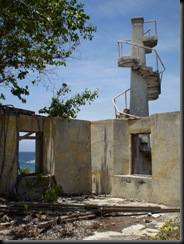 showcasing as well.
showcasing as well.
There were recent attempts to renovate the lighthouse, but these were clumsy at best. Architect German Torero of the National Commission for Culture and the Arts (NCCA), who will assist in the restoration and preservation efforts, explained to me that the newly added thin layer of cement on the walls will have to be taken off to expose the Spanish-era coral stones used in the original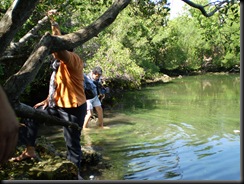 construction.
construction.
Exploring inland, I was taken to a lagoon in Barangay Looc where an edible species of seaweed locally known as lato (Caulerpa sp.) grows in abundance. Red shrimp and clams are also harvested during full  moons in a nearby shallow cavern.
moons in a nearby shallow cavern.
In Barangay Pantudlan, they have a majestic lake frequented by migratory birds. Locals do not venture into the lake for fear of being sucked in by quicksands. As a story Emmie told goes, a carabao once inadvertently wandered into the lake and was not seen again. The local fisherfolk constructed viewing decks made from discarded wooden cable spools of a telecommunication company – taking recycling to a whole new level, literally.
local fisherfolk constructed viewing decks made from discarded wooden cable spools of a telecommunication company – taking recycling to a whole new level, literally.
From the looks of it, Cabilao can stand as a 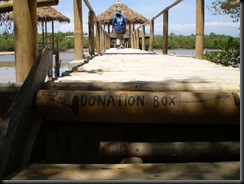 model for community-based sustainable resource management, and I hope to visit again the praiseworthy villagers that make this possible as soon as the lighthouse is finished.
model for community-based sustainable resource management, and I hope to visit again the praiseworthy villagers that make this possible as soon as the lighthouse is finished.